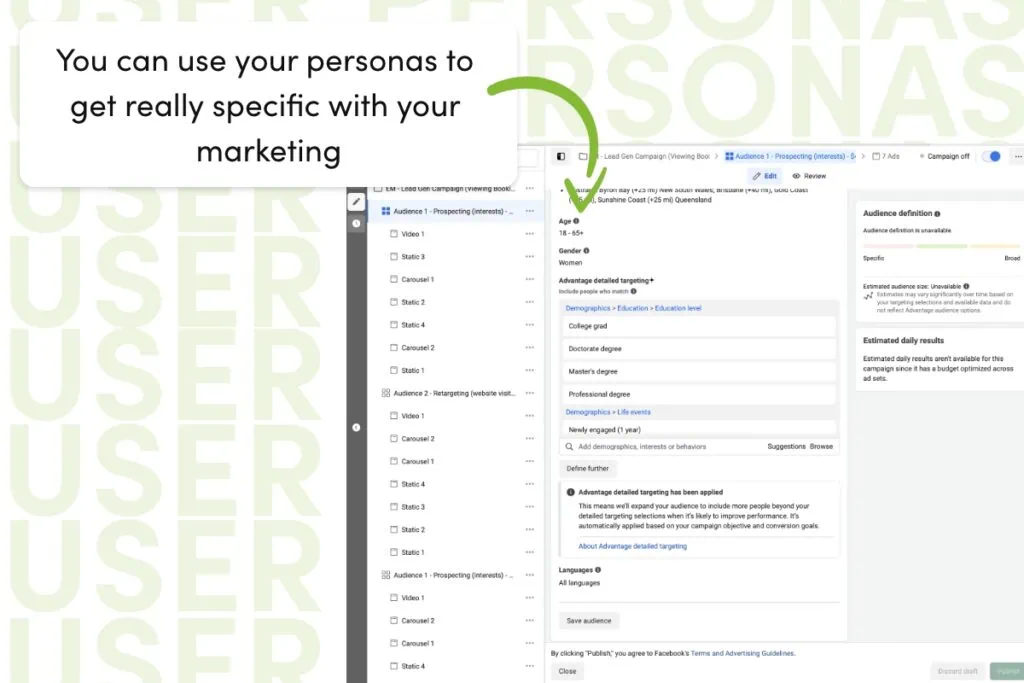User personas are a really important tool for marketers and business owners. These act as a guide for everything you do— the product you create, how you market it, and the language you use when you interact with your team.
By knowing exactly who your customers are, you can create products, marketing materials, and interactions that suit them down to the ground.
Table of Contents
ToggleThe TL;DR (too long, didn't read) 👇
- A user persona is a made up character that represents one type of customer you're targeting. It breaks down who they are, how they act, and how you can appeal to them.
- User personas are really useful to help you create products, content, and marketing choices that appeal to the right people.
- You can use your user personas when you develop new services, create your website, in your marketing materials, and as part of your customer service training.
- To create your user persona, gather data and research your current customer base, find the key patterns, and use that insight to develop 2-3 personas.

What is a user persona? 🧍🏻♂️
A user persona is where you make up an identity or a character, based on who your customers generally are.
Now, depending on what your business does, you might have one really specific user persona or 10 different personas.
For example, a national internet provider like Telstra is going to have quite a few, because they could theoretically service just about every adult in the country.
A childcare service on the other hand, might just have two or three different personas. Their target market is condensed to parents and caregivers of children.
Your user persona will define the demographic, what they do, what their goals and problems are, and how you can appeal to them best.
Here are the key parts of a user persona:
- Demographics (age, gender, location)
- Behaviours (habits, preferences)
- Pain points & challenges
- Goals & needs
- Motivations & personality traits

Why are user personas useful? 🛠️
User personas give you a really clear idea of who your audience is. When it comes to business and marketing, the entire idea is to appeal to your ideal customer.
And the only way you can do that is by knowing exactly who they are and what makes them tick.
At Excite Media, we have three user personas, and recently, we decided to make an eBook with just one of these personas in mind.
As I’ve been writing this eBook —which involves breaking down some pretty complex topics— I’ve had a persona in mind. Any time I’ve been unsure how much further I’ve needed to break down an idea or if I should explain a niche marketing term, I’ve known exactly what to do.
Because I know exactly who I’m writing for.
Here’s why we love user personas:
Get a true understanding of your audience 💚
The activity of creating your user personas really encourages you to sit down and think about who your audience is, what motivates them, and why you matter to them.
You’ll get to dig deeper into the data and find the patterns that give you real insight into who your customers are.
By doing this, you can paint a picture of exactly who they are, what they like, what they don’t, and how you can be the obvious choice when they need your service.
Know who you're writing, designing, developing for ✏️
By really knowing your audience, you can deliver personalised messaging directly to them. It means your copy will directly address their pain points and concerns. Your design and photography choices can appeal to them. And you can develop a website that suits their needs and how they interact with digital materials.
Market to the right person 👆
Make decisions based on data 📊
Create consistency in your messaging 💬

So, how do you use a user persona? ✨
So, you know what user personas are now and you know why we love them. But what’s the actual point of them?
When developing products 🛍️
Your user personas give you this really clear idea of exactly who it is that interacts with your brand and needs your services.
So, when you’re developing new products, using these personas as a guide can be really handy.
Think about who your audience is and what their problems are. Do they need the product? Can they afford it? Are they looking for it or will they need some convincing?
Creating your website 🖥️
To inform your marketing 📈
A huge one. Your marketing can only benefit from understanding exactly who you’re marketing to.
Your user personas help you understand what problems you need to speak to or address and where your potential customers spend their time online (Facebook vs. Instagram or LinkedIn vs YouTube).
You can better understand what they might be searching for on Google.
You can create special offers that appeal your user personas. Are they the kind of person who loves a discount? Are they careful people who want a trial month before they commit? Do they need to meet new service providers first? Is a free consultation ideal for them?
Ultimately, the success of your marketing hinges on your brand’s messaging. You really can’t go wrong if you’re personalising your brand’s message to these user personas.
To support your customer service team ☎️

A step by step guide to creating user personas
Have we sold you the dream of user personas for your business?
Perfect.
Here’s how you create them, step by step.
1. Start with the research
Gather all the data you have on your customer base.
You might find some useful data in these places:
- Your social analytics (look at the age range, gender, and other demographics of your most engaged followers)
- Your existing customers (who are they, where do they live)
- Survey your existing clients (you might find exchanging a discount or freebie can convince your clients to fill it in)
- Conduct interviews with a selection of your clients
2. Look for the key patterns
With all of the data in front of you, you can start looking at your customer base and the people who are interested in your business.
From this, you can look at exactly who they are.
- What kind of jobs and income do they have?
- How old are they? Where do they live?
- Do they have families? Are they parents?
- What are their goals when they come to you?
- What challenges do they need to overcome? What kinds of things are annoying them?
- What do they do? What marketing channels do they engage with? Are they looking for solutions like your business on Google? Or are they happy for it to come to them in the form of a paid LinkedIn Ad?
3. Create 2-3 personas
You’ve got all of your data and you’ve organised it into some cohesive ideas and categories.
Now, you’ve got everything you need to create your user personas.
It’s important that you create cohesive and realistic personas. It’s really handy to give each of your personas a name so you can get to really know them, too.
Here’s what your personas might look like.
| User Persona | Pain points | Goals | Digital behaviour | Channels |
|---|---|---|---|---|
|
Mining Operations Manager Mike
Operations Manager |
Frequent equipment breakdowns Delays in sourcing replacement parts High safety standards compliance Balancing environmental impact with profitability. |
Improve operational efficiency Reduce downtime Ensure safety regulations are met without compromising productivity. |
Mike frequently uses LinkedIn to connect with industry professionals and follows mining equipment manufacturers online. He relies on supplier websites and industry forums for equipment reviews and technical specifications. |
LinkedIn Google Search Email newsletters Online mining equipment supplier directories |
|
Civil Engineer Carl
Senior Civil Engineer |
Managing tight project deadlines Keeping up with new technologies in construction Ensuring compliance with environmental regulations Sourcing reliable contractors |
To deliver infrastructure projects on time and within budget, while adopting sustainable practices and ensuring structural integrity. | Carl is active on LinkedIn for industry news, attends virtual engineering conferences, and subscribes to engineering journals for updates on new materials and construction techniques. |
LinkedIn
Industry-specific blogs Engineering webinars Direct email marketing. |
|
Fabrication Foreman Frank
Foreman |
Sourcing high-quality materials
Maintaining skilled labour Dealing with tight deadlines Competing with low-cost overseas fabricators. |
Improve turnaround times for projects
Reduce material costs without sacrificing quality Attract more large-scale contracts. |
Frank looks for suppliers online and is subscribed to industry trade magazines. He also watches YouTube tutorials on new welding technologies and processes. |
YouTube
Industry forums Google Search Trade magazine advertising. |
4. Share the personas with your team & start using them
Once you’ve created all of your personas, roll them out and share them with your team.
You should use your personas to inform how you’re communicating with your target market from the very beginning of their awareness of you, through to when they’re a devoted client.
Need a hand with your digital marketing? We’d love to chat with you about what we can do for your business 👋




